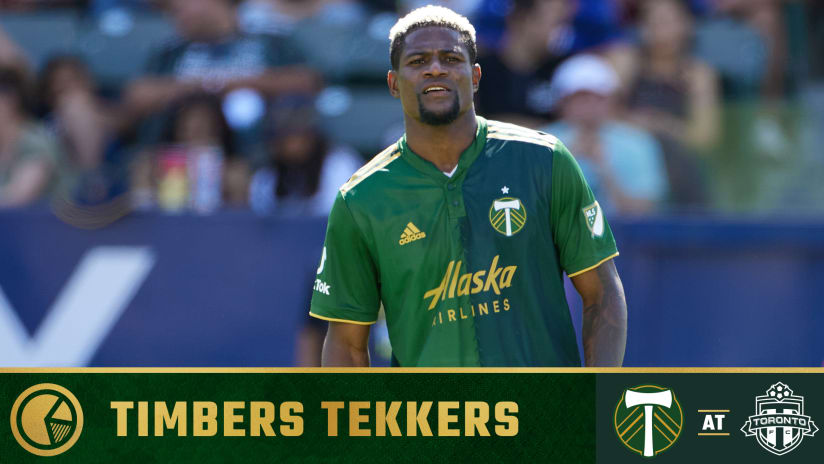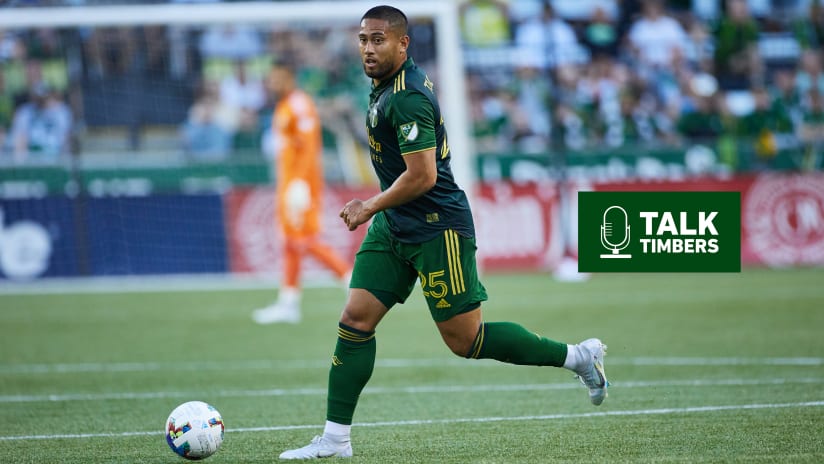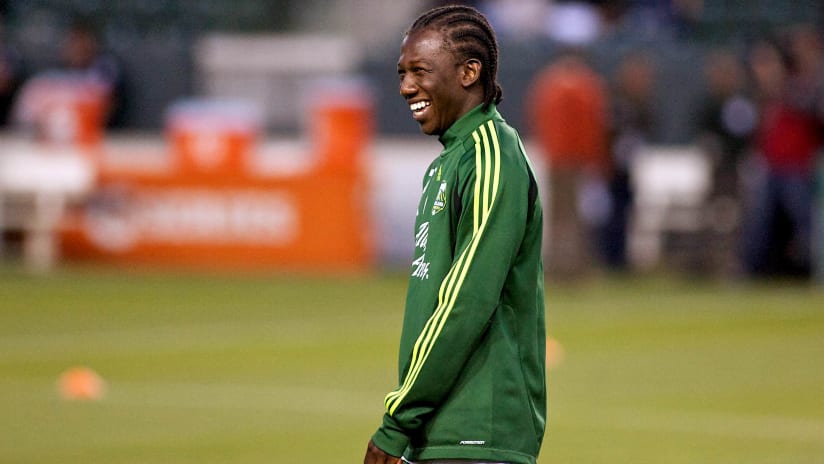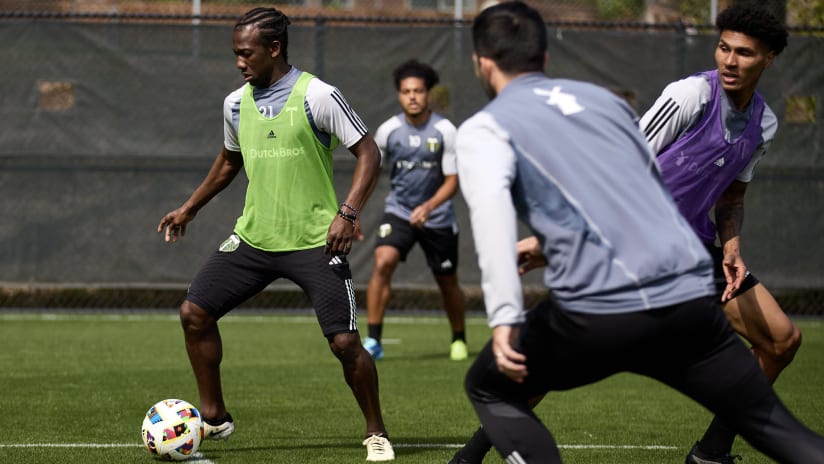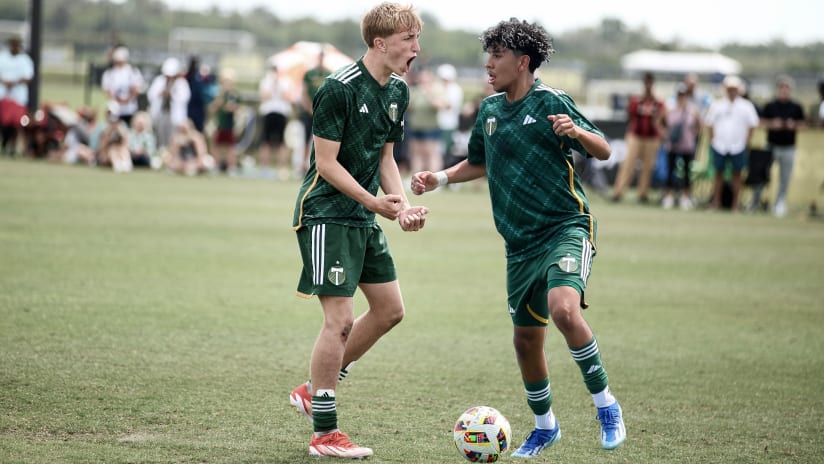The first word that should have come to mind for Portland Thorns FC fans when, two days ago, the Washington Spirit parted ways with then-head coach Jim Gabarra was “uncertainty.” That’s because, over the course of the season’s previous 21 games, the Spirit had established their tendencies. Teams knew the formations they liked, where they wanted to deploy their talent, and all the strengths and weaknesses those choices entailed.
Washington was a known commodity, albeit one that had only scored one goal in eight games; one that had not won a match since March. That’s has to be why the organization made their change, but in doing so, they injected a series of doubts into the Thorns coaching staff, who now have to prepare for a Spirit side engaging a new start.
That new start doesn’t take place on Saturday at Audi Field (5:00 p.m. PT, ESPNEWS). It already happened. Yesterday, while most Portland fans were finishing their work days or making their way to Providence Park, Tom Torres debuted as head coach of the Spirit, giving the Thorns their first glimpse of what to expect from Washington’s changing approach.
Some of those changes were obvious, like previous-backup goalkeeper Didi Haracic getting the start over Aubrey Bledsoe, or the team’s formation taking on a slightly different look. With other aspects, though, it was difficult to tell whether the Spirit had undergone a stylistic change or were just responding to the circumstances of their opponent.
Regardless, and as with any soccer game, there was a lot to learn from Torres’ coaching debut against Utah Royals FC. Here, in preparation for Saturday’s game, we’re only going to focus on the first 10 minutes with the hope that allows you to go to NWSLSoccer.com, hit play, and follow along. Suffice to say, while those first minutes were highly informative (and, in the nature of the goals' only goal, predictive), there’s much more over the 80 minutes that followed that illustrate the Spirit’s changed world.
For now, though, here’s what we know:
A formation that makes sense
Over the course of the season, Gabarra had largely played two formations: versions of the 4-3-3 which he’s leaned on heavily since his 2016 return to Washington, and a 3-4-3/3-4-1-2 look he’d been developing in recent months. On Wednesday, Torres used neither, instead going to a type of back-to-basics approach with a 4-2-3-1:
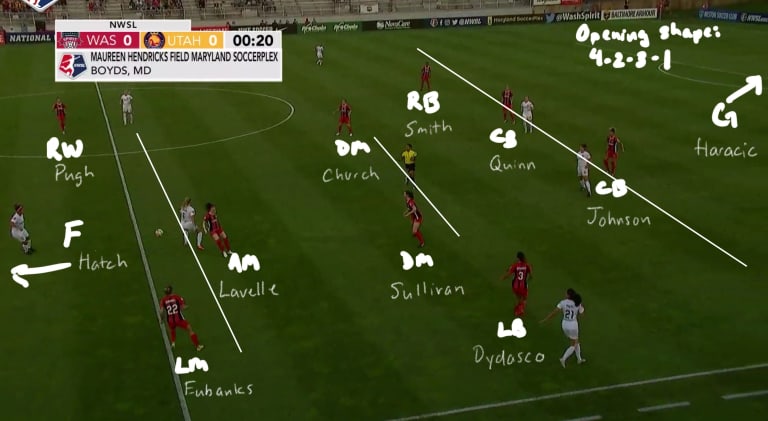
Excuse the markup – we’re going to keep things casual, for this post, to try to give some insight into how these things are broken down. Here, though, in the match’s early moments, you can see the way Washington wants to set up: four players in defense; a two-person partnership in the middle; with three attackers setting up behind a lone forward. Left back Caprice Dydasco is high in midfield because the ball, at the time of this screenshot, is just being circulated from her side of the field.
This look, over the last decade, has become the world’s default formation, and it’s one that makes sense to rely on if you’ve only had one practice with a squad. Torres was put in that situation this week and implemented a system which almost any player on a high-level roster should be able to play. If the Spirit were going to go away from Gabarra’s looks, they at least picked a familiar approach.
Player for player, though, when looking at the squad’s strengths and weaknesses, the choice made a lot of sense:
- Didi Haracic, in goal, stepped in for Bledsoe, who could still develop into a solid NWSL No. 1. But Bledsoe has struggled at points this season with her decision-making and execution. Many goalkeepers experience the same bumps when taking on a starting job for the first time, but particularly if the Spirit were going to lean on their goalkeeper’s decisions by playing a high line (more on this, later), giving Bledsoe a break made sense in Torres’ game one.
- Rebecca Quinn, having spent part of this season wedged into midfield (a role she is capable of playing), was not only put into her strongest position, central defense, but next to a player in Estelle Johnson who has the quickness to cover for Quinn’s occasional lack of pace.
- Whitney Church, good on the ball and smart with her decisions, is put into a midfield role where her lack of speed can’t be exploited as it often was in central defense.
- Andi Sullivan, next to a player like Church who can handle the ball-winning and defensive work, is free to think about having more of an impact going forward.
- Rose Lavelle is put into a role where creating is her near-only responsibility – where she will neither have to track players defensively or win the ball.
- Mallory Pugh, out wide – not in the middle or up top – will almost always have space to receive the ball, turn toward defenders, and have a field’s worth of options.
- And Ashley Hatch, whose ability to play a lone striker’s role is leveraged so Torres can reinforce elsewhere on the field
For more than half of the Spirit’s Wednesday XI, the move to a 4-2-3-1, as well as the night’s selection, puts them in a better position than they were before. For the rest – players like Johnson, fullbacks Taylor Smith and Dydasco, and left midfielder Mallory Eubanks – the deployment made sense, too, especially with a willing player like Eubanks able to help Dydasco against Utah’s most-dangerous player, U.S. international Christen Press.
The new formation, in action
Going forward, you can see a number of those benefits in this, a fourth minute turnover which, had one touch gone a different way, would have been a very dangerous chance for the Spirit:
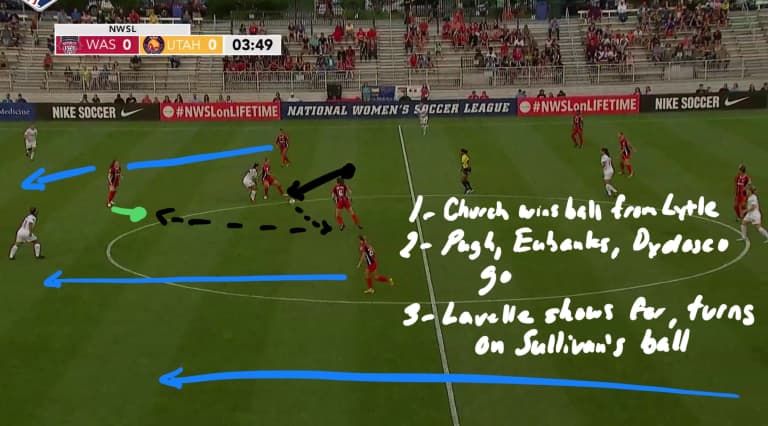
What you see, here, is Church winning a ball off Utah’s Taylor Lytle, one the Royals midfielder has taken a poor touch on. That allowed Church to separate Lytle from the ball and immediately play to her midfield pivot partner, Sullivan. One touch later, the ball’s played to Lavelle, and a moment after that (following some nice footwork and another short pass), Dydasco, streaking forward from her left back position, has all the space in the world.
That space, though, is a function of the set up. In the midfield, we saw how the three Spirit players worked, but as the ball is won, both Pugh and Eubanks burst forward. That forces the Utah defense to get tight and opens up the flank for Dydasco. Moments later, the Spirit are left with this chance:
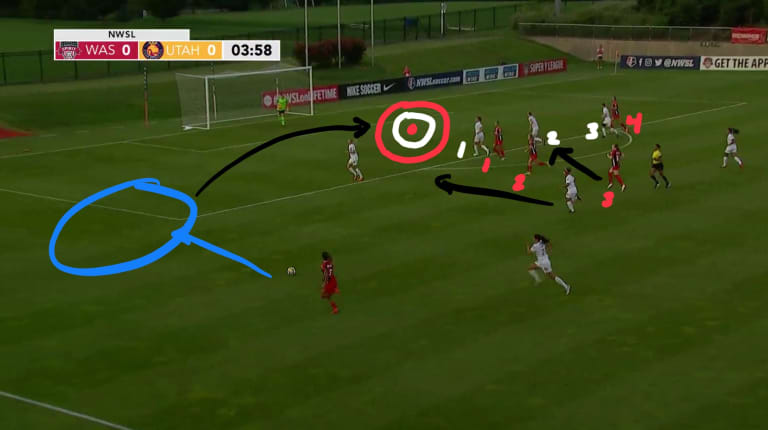
That bullseye you see at the far post? That’s where Dydasco needs to play that ball, and as you can see, she has all the space she needs to execute. Get to that ball before Press (flying to track back), play it eight or 10 yards from goal, and the Spirit will have a four-on-three edge attacking that far-post ball.
Unfortunately, Dydasco didn't have the technique to play the ball first time; or, she just made the wrong decision. Either way, the Washington left back gave Press enough time to close the distance and prevent her from getting the cross off.
Beneath that decision, though, is a moment of danger, one that was born of three major elements: Lytle’s bad touch; Torres’ new setup; and the approach Washington used in transition. Dydasco played a number decent balls in throughout the match, but in this instant – an instant that could have ended the Spirit’s goal-scoring drought – she couldn’t get her cross off.
The space behind
Another element that was evident from Wednesday’s opening moments was how Utah was targetting the area behind Washington’s back line.
This has been a problem for the Spirit for almost two years, so much so that during the offseason, they remade their defense. The central pairing of Church and Shelina Zadorsky, exploited so often for their lack of pace, was broken up, Johnson was brought in from right back to use her speed in the middle, while Taylor Smith’s acquisition gave them another defender who could keep pace with the rest of the league.
Problem solved, right? Unfortunately, theory has never met execution for the Spirit defense, and amid a season in which the team has allowed 33 goals (only Sky Blue has conceded more), the back line is still a problem.
As Utah showed early and often, the space between defense and goal can still be targeted. Five times in the game’s first 10 minutes, the Royals tried to play balls in behind, whether they were small chips over defense (second minute), long and direct plays forward (fourth) or through balls into seems (eighth). Utah came out of the locker room trying to hit Washington in behind.
For the Thorns, this fifth minute sequence may be the most informative example. Here, Press has, loses, and regains possession just outside her own penalty area. Once she gets the ball back, she turns and plays a long, left-footed ball down the right flank. This isn’t the type of play were you see something develop and you give it a chance. It’s the fifth minute. She just turned and fired.
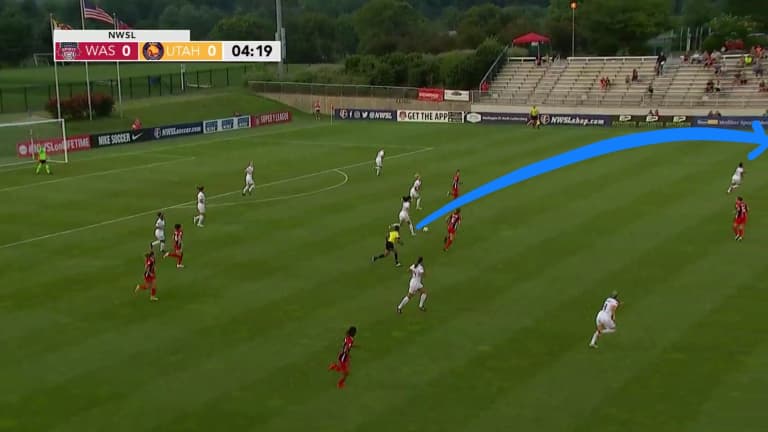
The result is a transition opportunity, below, that practically mirrored the one Washington had before. As Lytle pursues Press’ pass, teammates' runs toward the back post give Utah an opportunity, should they execute. Lytle needs to hit the right ball, and then Amy Rodriguez, the most advanced player, will probably need to head down for either Katie Stengel (number 2, white) or Gunnhildur Jonsdottir (3). Everybody needs to win their individual battles, but if they do, Utah should end up with a good chance on goal.
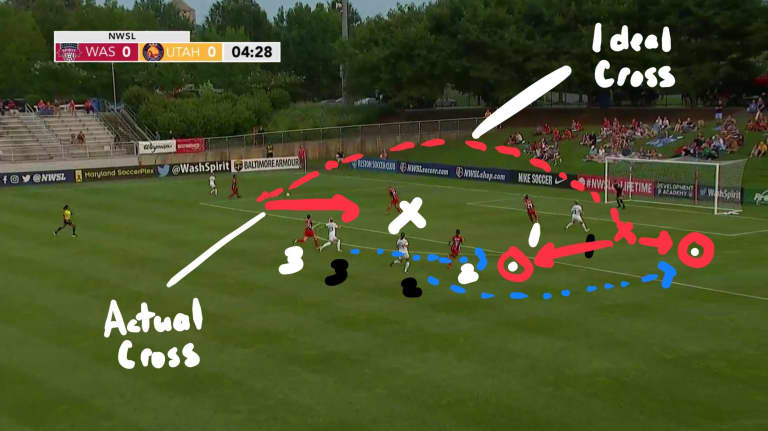
What happens? Lytle does Dydasco one better and actually gets a cross off, but it’s played low and never reaches any of her teammates. This, the third time Utah tried to turn Washington’s defense, was their most successful up to that moment, but it also didn’t come close to producing a chance on goal.
Still, this is something the Thorns should feel optimistic about. Nobody plays a better long ball in the NWSL than Lindsey Horan, who would be in Press’ position in Portland’s defensive phase. Tobin Heath, Caitlin Foord (or Ana Crnogorcčević) and Hayley Raso all have the speed to claim the ball Lytle ran onto, and between those attackers and Christine Sinclair, the Thorns are capable of getting enough numbers into the box.
Be it long …
.. or short …
.. the Spirit still need to improve when it comes to protecting the space in behind. Haracic may be getting her shot to do just that, now. Still, it was an area Utah felt comfortable targeting early and often.
Dealing with the press
Another problem facing Washington is how to deal with the Thorns’ high pressure, which can be among the most effective in the league. We talked about that a bit when reviewing the recent Chicago Red Stars game, but as it concerns Washington, Utah provided a good, early example of what an intelligent scheme can do to disrupt Torres’ group:
Washington’s players have to be quicker and smarter about how they move the ball, though some of what we’re seeing, here, may have to do with the team’s changing approach. It’s one thing for a new coach to say “We’re going to play a 4-2-3-1” and know his players can manage the change. It’s another when you’ve got smart opponents applying pressure, reminding you that, within the new scheme, players haven’t gotten used to where, as opponents push, they need to move to provide options.
There's also the technique element to this, too. As Utah is pressing Spirit players, the ball is never truly settled. There are very few things these players can do with a bouncing ball, particularly those who play it with their back to the field. All they can do is try to set up their teammates to have better options, but even then, it isn't until the end of this sequence that Washington finally gets the ball back on the group.
Here’s what should truly be scary for Washington, though: They were having trouble moving the ball against Utah, a team that was pressing with people like Lytle, Rodriguez, and Stengel. The Thorns have Foord and Crnogočević. They have Raso, as well as Heath. Even off the bench, if Mark Parsons wants to make his former team’s life hell, he can bring in Mallory Weber, Tyler Lussi, and potentially move Midge Purce or Ellie Carpenter into attack.
There may be only one team, the North Carolina Courage, that can apply more pressure than the Portland Thorns. If Washington had trouble with Utah, they may really be streamrolled when, travel legs providing, Portland decides to push.
The scheme on set pieces
And finally, take a look at what the Spirit’s marking is like on this early corner kick:

There’s a lot, here, in this image, and the handwriting is getting a little sloppy, but the basic elements tell you the Thorns can have some success on set pieces.
Washington is going with a mixed-marking scheme, leaving some players to mark zonally in the six-yard box while a couple of players are high, trying to disrupt opponents’ runs. That leads to a five-versus-two edge in the six-yard box but – and most important for Horan’s chances to building on her 11 goals – a disadvantage higher up. Even if that advantage doesn't directly produce a goal, the unmarked player just outside the box – who, for Portland, might end up being somebody like a Celeste Boureille – could get a clean shot on goal.
During live action, some of the defenders in the six-yard box are going to attack toward the penalty spot, but the prospect of Horan getting a free run at the ball, finishing in the same target zone from which she’s scored before, has to be encourage for Thorns coaches. Even if she's marked, the ability of a players like Christine Sinclair or Crnogorčević to set up others may give Portland multiple options.
What we know
And that was all in the first 10 minutes of Washington’s loss to Utah, and while none of that led to a good chance for either side, come the match's 12th minute, Utah forced a turnover high, got Rodriguez behind Washington's defense, and scored the match's only goal:
With only two wins on the season, Washington clearly has a long way to go, and with their Tuesday coaching change, the Spirit likely feel they took the first step toward a different tomorrow. But in the present – the today of the 2018 NWSL season – the team still reflects a mixed bag of highly-talented individuals and uncertain fit. Torres' changes give the team a new look, but the principles beneath that appearance still need to evolve.




